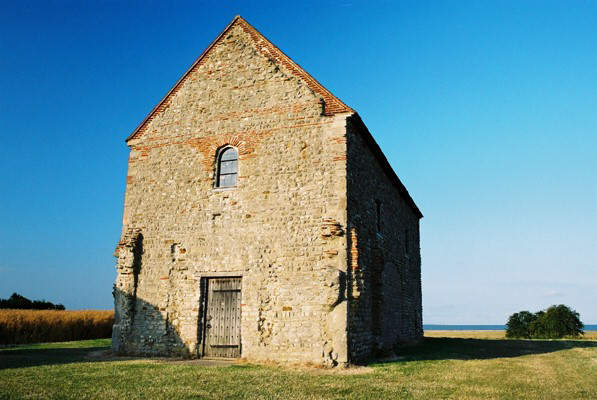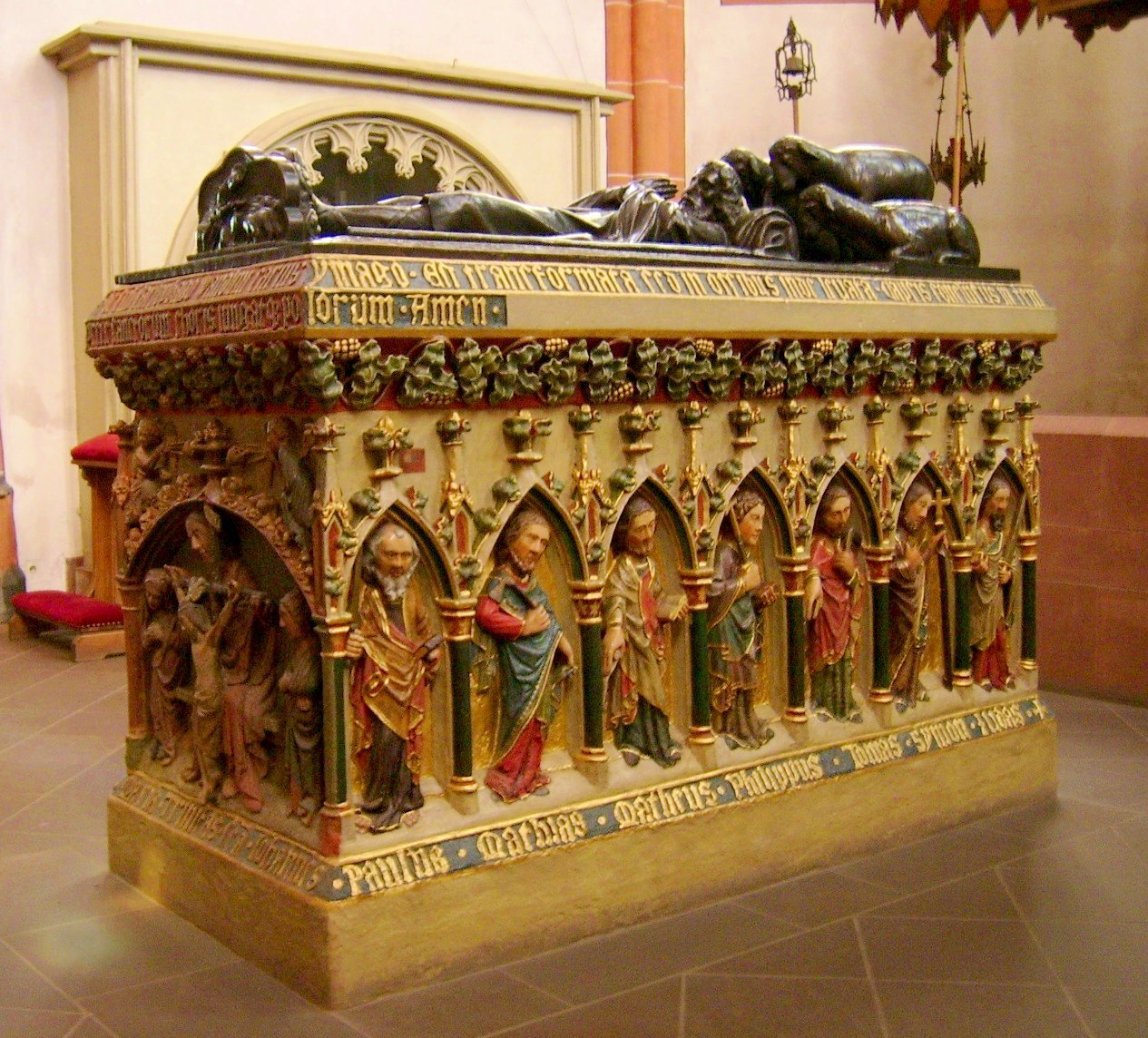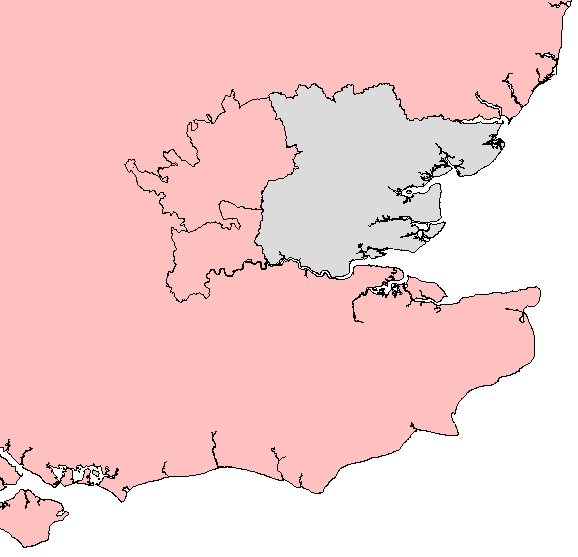|
Sæward Of Essex
Sæward was the joint king of the Kingdom of Essex from 616? to 623? along with his brother Sexred after the death of their father Sæbert. Their father converted to Christianity in 604. After his death they repressed the Christian religion in favor of the indigenous English religion, allowing the worship of their people's native gods. They banished Mellitus, Bishop of London, from the kingdom after he refused them the sacramental bread. In 623(?) Sexred, Sæward and their brother were killed in a battle against the forces of Wessex. It is uncertain whether Sigeberht, son of Sæward, was their successor Sigeberht the Little or the latter's successor Sigeberht the Good Sigeberht II, nicknamed the Good (''Bonus'') or the Blessed (''Sanctus''), was King of the East Saxons (r. ''c''. 653 to ? 660 x 661), in succession to his relative Sigeberht I the Little. Although a bishopric in Essex had been created under Mel .... 617 deaths Sexred of Essex Anglo-Saxons killed ... [...More Info...] [...Related Items...] OR: [Wikipedia] [Google] [Baidu] |
Essex
Essex () is a county in the East of England. One of the home counties, it borders Suffolk and Cambridgeshire to the north, the North Sea to the east, Hertfordshire to the west, Kent across the estuary of the River Thames to the south, and Greater London to the south and south-west. There are three cities in Essex: Southend, Colchester and Chelmsford, in order of population. For the purposes of government statistics, Essex is placed in the East of England region. There are four definitions of the extent of Essex, the widest being the ancient county. Next, the largest is the former postal county, followed by the ceremonial county, with the smallest being the administrative county—the area administered by the County Council, which excludes the two unitary authorities of Thurrock and Southend-on-Sea. The ceremonial county occupies the eastern part of what was, during the Early Middle Ages, the Anglo-Saxon Kingdom of Essex. As well as rural areas and urban areas, it forms ... [...More Info...] [...Related Items...] OR: [Wikipedia] [Google] [Baidu] |
Sigeberht The Good
Sigeberht II, nicknamed the Good (''Bonus'') or the Blessed (''Sanctus''), was King of the East Saxons (r. ''c''. 653 to ? 660 x 661), in succession to his relative Sigeberht I the Little. Although a bishopric in Essex had been created under Mellitus, the kingdom had lapsed to paganism and it was in Sigeberht's reign that a systematic (re-)conversion of the East Anglians took root. Bede's ''Historia Ecclesiastica'', Book III, chapter 22, is virtually the sole source for his career. Family Apart from referring to the odd kinsman, Bede offers little that is of help in determining Sigeberht's family connections. Additional evidence is provided by genealogies for Offa, Swithred and Sigered in a 9th-century West-Saxon manuscript and in two post-Conquest sources: William of Malmesbury's ''Gesta regum'' and John of Worcester's ''Chronicon ex Chronicis'', the latter including a memorandum (''Chronicon'' A) and a genealogical list (''Chronicon'' B). Their testimony is at times confused ... [...More Info...] [...Related Items...] OR: [Wikipedia] [Google] [Baidu] |
Year Of Birth Unknown
A year or annus is the orbital period of a planetary body, for example, the Earth, moving in its orbit around the Sun. Due to the Earth's axial tilt, the course of a year sees the passing of the seasons, marked by change in weather, the hours of daylight, and, consequently, vegetation and soil fertility. In temperate and subpolar regions around the planet, four seasons are generally recognized: spring, summer, autumn and winter. In tropical and subtropical regions, several geographical sectors do not present defined seasons; but in the seasonal tropics, the annual wet and dry seasons are recognized and tracked. A calendar year is an approximation of the number of days of the Earth's orbital period, as counted in a given calendar. The Gregorian calendar, or modern calendar, presents its calendar year to be either a common year of 365 days or a leap year of 366 days, as do the Julian calendars. For the Gregorian calendar, the average length of the calendar year ( ... [...More Info...] [...Related Items...] OR: [Wikipedia] [Google] [Baidu] |
7th-century English Monarchs
The 7th century is the period from 601 ( DCI) through 700 ( DCC) in accordance with the Julian calendar in the Common Era. The spread of Islam and the Muslim conquests began with the unification of Arabia by Muhammad starting in 622. After Muhammad's death in 632, Islam expanded beyond the Arabian Peninsula under the Rashidun Caliphate (632–661) and the Umayyad Caliphate (661–750). The Muslim conquest of Persia in the 7th century led to the downfall of the Sasanian Empire. Also conquered during the 7th century were Syria, Palestine, Armenia, Egypt, and North Africa. The Byzantine Empire suffered setbacks during the rapid expansion of the Caliphate, a mass incursion of Slavs in the Balkans which reduced its territorial limits. The decisive victory at the Siege of Constantinople in the 670s led the empire to retain Asia Minor which assured the existence of the empire. In the Iberian Peninsula, the 7th century was known as the ''Siglo de Concilios'' (century of councils) ref ... [...More Info...] [...Related Items...] OR: [Wikipedia] [Google] [Baidu] |
Anglo-Saxons Killed In Battle
The Anglo-Saxons were a cultural group who inhabited England in the Early Middle Ages. They traced their origins to settlers who came to Britain from mainland Europe in the 5th century. However, the ethnogenesis of the Anglo-Saxons happened within Britain, and the identity was not merely imported. Anglo-Saxon identity arose from interaction between incoming groups from several Germanic tribes, both amongst themselves, and with indigenous Britons. Many of the natives, over time, adopted Anglo-Saxon culture and language and were assimilated. The Anglo-Saxons established the concept, and the Kingdom, of England, and though the modern English language owes somewhat less than 26% of its words to their language, this includes the vast majority of words used in everyday speech. Historically, the Anglo-Saxon period denotes the period in Britain between about 450 and 1066, after their initial settlement and up until the Norman Conquest. Higham, Nicholas J., and Martin J. Ryan. ''The An ... [...More Info...] [...Related Items...] OR: [Wikipedia] [Google] [Baidu] |
East Saxon Monarchs
East or Orient is one of the four cardinal directions or points of the compass. It is the opposite direction from west and is the direction from which the Sun rises on the Earth. Etymology As in other languages, the word is formed from the fact that east is the direction where the Sun rises: ''east'' comes from Middle English ''est'', from Old English ''ēast'', which itself comes from the Proto-Germanic *''aus-to-'' or *''austra-'' "east, toward the sunrise", from Proto-Indo-European *aus- "to shine," or "dawn", cognate with Old High German ''*ōstar'' "to the east", Latin ''aurora'' 'dawn', and Greek ''ēōs'' 'dawn, east'. Examples of the same formation in other languages include Latin oriens 'east, sunrise' from orior 'to rise, to originate', Greek ανατολή anatolé 'east' from ἀνατέλλω 'to rise' and Hebrew מִזְרָח mizraḥ 'east' from זָרַח zaraḥ 'to rise, to shine'. ''Ēostre'', a Germanic goddess of dawn, might have been a personificatio ... [...More Info...] [...Related Items...] OR: [Wikipedia] [Google] [Baidu] |
617 Deaths
__NOTOC__ Year 617 ( DCXVII) was a common year starting on Saturday (link will display the full calendar) of the Julian calendar. The denomination 617 for this year has been used since the early medieval period, when the Anno Domini calendar era became the prevalent method in Europe for naming years. Events By place Byzantine Empire * Byzantine-Sassanid War: The Persian army under Shahin Vahmanzadegan conquers Chalcedon in Anatolia, and reaches the Bosporus, threatening Constantinople. Emperor Heraclius begins peace negotiations, promising an annual tribute of 1,000 talents of gold and silver. Shahin withdraws with his army to Syria, to focus on the invasion of Egypt. * The Avars send envoys to Constantinople for a meeting with Heraclius. He is warned about an ambush, and flees for safety behind the city walls in time. Angry at the failure to capture the Byzantine emperor, the Avars plunder Thrace and return to the Danube River, carrying off 270,000 people. Europe ... [...More Info...] [...Related Items...] OR: [Wikipedia] [Google] [Baidu] |
Kingdom Of Essex
la, Regnum Orientalium Saxonum , conventional_long_name = Kingdom of the East Saxons , common_name = Essex , era = Heptarchy , status = , status_text = , government_type = Monarchy , event_start = , date_start = , year_start = 527 , event_end = , date_end = , year_end = 825 , event1 = , date_event1 = , event2 = , date_event2 = , event3 = , date_event3 = , event4 = , date_event4 = , p1 = Sub-Roman Britain , flag_p1 = Vexilloid of the Roman Empire.svg , border_p1 = no , s1 = Kingdom of England , flag_s1 = Flag of Wessex.svg , border_s1 = no , image_flag = , flag = , flag_type = , image_ ... [...More Info...] [...Related Items...] OR: [Wikipedia] [Google] [Baidu] |
Sigeberht The Little
Sigeberht the Little was king of Essex from 623? to 653. A Sigeberht was the son of Sæward, who was slain in battle against forces from Wessex in 623(?), and father of later king Sighere, but Yorke thought it more likely this was his successor, Sigeberht the Good. Sigeberht the Little was considered a pagan and most likely allied with Penda of Mercia in 635, who was also a pagan. After his death, he was succeeded by his relative, Sigeberht the Good. References External links * 653 deaths Anglo-Saxon warriors Anglo-Saxon pagans Sigeberht I of Essex Sigeberht the Little was king of Essex from 623? to 653. A Sigeberht was the son of Sæward, who was slain in battle against forces from Wessex in 623(?), and father of later king Sighere, but Yorke thought it more likely this was his successor, ... 7th-century English monarchs Year of birth unknown {{England-bio-stub ... [...More Info...] [...Related Items...] OR: [Wikipedia] [Google] [Baidu] |
Sexred
Sexred, or Sexræd (d. 626?), was a king of the East Saxons. Sexred was the son of Sæberht (d. 616?) the first Christian king of the East Saxons, whom he succeeded, reigning jointly with his two brothers, Saeward and another, said on no good authority to have been named Sigebert (Bromton, ap. Decem SS. col. 743) but perhaps the unplaced Seaxbald, father of Swithhelm.Yorke, Barbara. "The Kingdom of the East Saxons." Anglo-Saxon England 14 (1985): 1-36. Sexred refused to accept Christianity, openly practised paganism and gave permission to his subjects to worship their idols. When he and his brothers saw Mellitus (d. 624), bishop of London, giving the eucharist to the people in church, it was commonly believed in the Venerable Bede's time that they said to him, "Why do you not offer us the white bread that you used to give to our father Saba, for so they called him, and which you still give to the people?" Mellitus answered that if they would be washed in the font they should ... [...More Info...] [...Related Items...] OR: [Wikipedia] [Google] [Baidu] |
Wessex
la, Regnum Occidentalium Saxonum , conventional_long_name = Kingdom of the West Saxons , common_name = Wessex , image_map = Southern British Isles 9th century.svg , map_caption = Southern Britain in the ninth century , event_start = Established , year_start = 519 , event_end = English unification , year_end = 12 July 927 , event1 = , date_event1 = , event_pre = Settlement , date_pre = 5th–6th century , event_post = Norman conquest , date_post = 14 October 1066 , border_s2 = no , common_languages = Old English *West Saxon dialect British Latin , religion = PaganismChristianity , leader1 = Cerdic (first) , leader2 = Ine , leader3 = Ecgberht , leader4 = Alfred the Great , leader5 ... [...More Info...] [...Related Items...] OR: [Wikipedia] [Google] [Baidu] |
Sacramental Bread
Sacramental bread, also called Communion bread, Eucharistic bread, the Lamb or simply the host ( la, hostia, lit=sacrificial victim), is the bread used in the Christian ritual of the Eucharist. Along with sacramental wine, it is one of two elements of the Eucharist. The bread may be either leavened or unleavened, depending on tradition. Catholic theology generally teaches that at the Words of Institution the bread's substance is changed into the Body of Christ (transubstantiation), whereas Eastern Christian theology generally views the epiclesis as the point at which the change occurs. Bread was also used in Jewish Temple ritual as well as in the religious rituals of Mandaeism, Mithraism, and other pagan cultures like that of ancient Egypt. Christianity Etymology of ''host'' The word ''host'' is derived from the Latin , which means 'sacrificial victim'. The term can be used to describe the bread both before and after consecration, although it is more correct to use it a ... [...More Info...] [...Related Items...] OR: [Wikipedia] [Google] [Baidu] |






